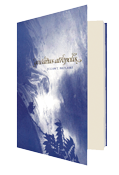It is said that what was remarkable in Willem de Kooning’s paintings wasn’t the rendering of an image but the way de Kooning moved the paint according to how he felt it should move. Punk country poet Julian T. Brolaski’s gowanus atropolis does not so much explore as gather thoughts—on politics, place, people, and sex—and the way Brolaski chooses to render them is, similarly, by moving the words and symbols into a unique amalgam. Brolaski’s innovation with the paint, as it were—the word choice, the syntax, the invention of words and of terms—recycles the ash of the already-been landscape into something beautiful.
This innovation takes shape around Brolaski’s keen ability to couch relevant issues in generalized approaches to a culture of thought democracy: relevant issues such as war and despair in a modern Western construct, love and despair in a modern Western construct, money and despair in a modern Western construct. Brolaski introduces political dialogue while usurping its causes as metaphors for the individual—when bringing up topics like war or money, the poet creates new ways to reveal the self. Brolaski’s entry points are unexpected, our subject matter the individual and the collective at once. Peeling away the paint of the zeitgeist, though, we also find a greater sense of a longing for sense—sense which, here, is arrived at through triumphant discussions of masculinity. “Wimp become hunk,” Brolaski writes, simply and genderlessly balancing on a canyon-crossing suspension bridge: “discovered a name’s / an elastic thing / one writes not so much about / as around homosexual desire.”
Brolaski’s talent for self-awareness, even in those moments when the poet is most vulnerable, offers a lovely reflection of the times in which we reside—where so much of communication exists electronically, and so much entertainment the same. Brolaski is part of the movement to bring internet linguistics and pop-culture allusion further into the modern poetic canon; those crucially concerned with language will note gowanus atropolis‘s loud and unapologetic re-twixting of letters—she and he become xe repeatedly, not so much bending gender as holding it above one’s head and blurring it in sunlight—as well as the extensive pop reference base it deploys. Brolaski moves from Chaucerian wordsmithing to hip-hop cloning to #webtalk; the aggregate #works for xim.
Gowanus atropolis moves us from common issues toward an account not only of the collective thought-state of the country...
You have reached your article limit
Sign up for a digital subscription and continue reading all new issues, plus our entire archives, for just $1.50/month.
Already a subscriber? Sign in





